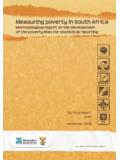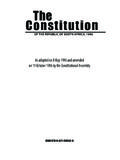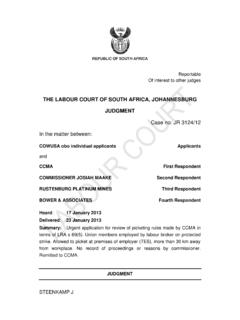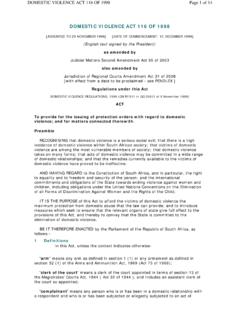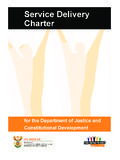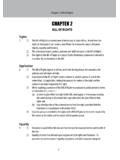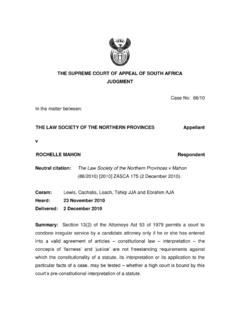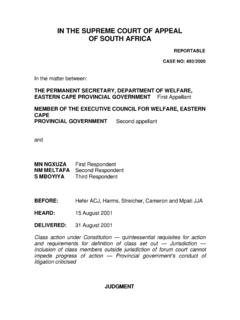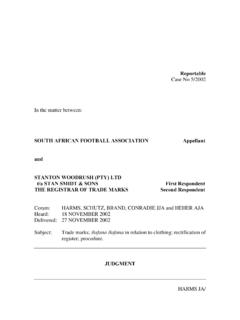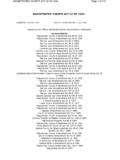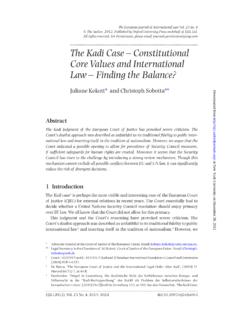Transcription of THE SUPREME COURT OF APPEAL OF SOUTH …
1 THE SUPREME COURT OF APPEAL OF SOUTH AFRICA JUDGMENT Not Reportable Case No.: 1121/17 In the matter between: HENDRIK PETRUS HOUGH Applicant and MZUBANZI SISILANA (ASSISTANT MASTER,WCDHC) First Respondent SEARDEL INVESTMENT CORPORATION LIMITED Second Respondent (renamed: E MEDIA HOLDINGS LIMITED) JOINT EXECUTORS: ESTATE LATE AARON SEARLL Third Respondent (Master s ref 6360/2010) [LAUREN SEARLL NO, ELLIOT OSRIN NO, JEFFREY FLAX NO, DAVID FRIEDLAND NO, QUINTIN HONEY NO] EDWARD NATHAN SONNENBERGS INC.
2 Fourth Respondent EUGENE NEL NO Fifth Respondent (Master s ref C337/2015) Neutral citation: Hendrik Petrus Hough v Mzubanzi Sisilana and others (1121/2017) [2018] ZASCA 04 (2 February 2018) Coram: Maya P Heard: In Chambers Delivered: 2 February 2018 Summary: Procedure s 17(2)(f) of the Superior Courts Act 10 of 2013 exceptional circumstances warranting an order for the reconsideration and variation of the dismissal of the application for leave to APPEAL not established application dismissed.
3 2 _____ ORDER _____ On application in terms of s 17(2)(f): SUPREME COURT of APPEAL (Ponnan JA and Schippers AJA): 1 Condonation as applied for is granted. The applicant is to pay the costs of the application. 2 The application in terms of s 17(2)(f) of the SUPREME COURT Act 10 of 2013 is dismissed with costs for the reason that no exceptional circumstances warranting reconsideration or variation of the decision refusing the application for leave to APPEAL have been established. _____ REASONS _____ Maya P: [1] The applicant brought an application in terms of s 17(2)(f) of the Superior Courts Act 10 of 2013 (the Act).
4 He sought (a) condonation for his failure to bring the proceedings within the prescribed time limits; (b) reconsideration and variation of the order of this COURT dated 22 August 2017 which dismissed his application for leave to APPEAL against the judgment of the Western Cape High COURT (Engers AJ); (c) an order granting him such leave and (d) costs. I dismissed the application, without furnishing substantive reasons therefor, on the basis that no exceptional circumstances warranting the reconsideration or variation of the decision refusing the application for leave to APPEAL had been established.
5 The following are my reasons for the decision. 3 [2] I mention at the outset that the applicant s prayer to be granted leave to APPEAL against the judgment of the high COURT was incompetent. In terms of s 17(2)(f) of the Act [t]he decision of the majority of judges considering an application referred to in paragraph (b), or the decision of the COURT , as the case may be, to grant or refuse the application [for leave to APPEAL ] shall be final: Provided that the President of the SUPREME COURT of APPEAL may in exceptional circumstances, whether of.
6 Her own accord or on application filed within one month of the decision, refer the decision to the COURT for reconsideration and, if necessary, variation. Subsection (2)(b) mentioned above refers to an application for leave to APPEAL to the SUPREME COURT of APPEAL made pursuant to the refusal of leave to APPEAL by the COURT against whose decision an APPEAL is sought. It is readily apparent from the ordinary wording of these provisions that the relief provided in s 17(2)(f) relates only to the dismissal of an application for leave to APPEAL by the SUPREME COURT of APPEAL .
7 Thus the President of this COURT may only direct the APPEAL judges who considered the application to revisit their decision and no more. [3] The facts of the case and the parties contentions are comprehensively set out in the two judgments of the high COURT and need not be rehashed in any great detail for present purposes. As I understand it, the applicant s estate was finally sequestrated by the high COURT at the instance of the second respondent, Seardel Investment Corporation Ltd (Seardel), on the basis of several taxed and allocated bills of costs in the latter s favour against the applicant.
8 These proceedings arise from the applicant s challenge, inter alia, to the admission to prove certain claims, including ENS taxed bill of costs, against his estate by the first respondent, the Assistant Master of the Western Cape High COURT , pursuant to a meeting of the creditors convened under the provisions of s 40(1) of the Insolvency Act 24 of 1936. One of the applicant s grounds for the review proceedings he brought in terms of s 151 of the Insolvency Act (upon which he solely relies in this application) was that Seardel had 4 no locus standi to sequestrate his estate as it was not his creditor.
9 This was so, he contended, because the taxed costs were incurred by Seardel s attorneys, Edward Nathan Sonnenbergs Inc (ENS), a personal liability company which had no Fidelity Fund certificate in its own name. Even though ENS directors all have the certificates in their personal names, the lack of its own certificate was in breach of the law as it is a practitioner as defined in s 1 read with s 23 of the Attorneys Act 53 of 1979 and was thus obliged under s 41(1) and (2) of this Act to have the certificate in its name to lawfully practise and earn fees and disbursements.
10 The second to fourth respondent s disavowed the inclusion of a company or any other juristic person in the Act s definition of a practitioner . For that reason, so they argued, s 41 of the Act does not apply to ENS and it is not required to have the certificate. The high COURT dismissed the review application with costs. The applicant s subsequent applications for leave to APPEAL to APPEAL against this decision both in the high COURT and in this COURT failed, hence this application. [4] It appears that the applicant previously challenged ENS authority to represent Seardel in the sequestration proceedings on the same ground that ENS could not lawfully do so without the certificate.
